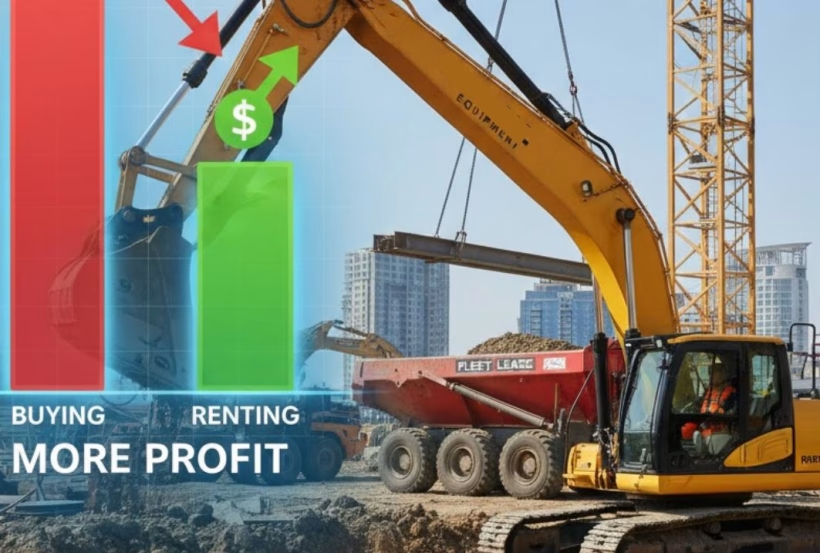The decision to buy or hire industrial equipment seems straightforward on the surface. Buying means owning the asset, controlling its availability, and avoiding ongoing rental costs. Hiring means flexibility and no capital outlay, but continuous payments for equipment that never becomes owned. Most businesses default to buying when they can afford it, viewing ownership as the more economical long-term choice.
But the math isn’t always that simple. Equipment ownership creates costs and constraints that don’t show up in purchase price comparisons. Hiring provides benefits beyond just avoiding the upfront payment. The situations where hiring delivers better business value than buying are more common than many business owners realize, and they extend well beyond just short-term or one-off needs.
The True Cost of Equipment Ownership
Purchasing industrial equipment involves more than just the initial price. The ongoing costs of ownership accumulate throughout the equipment’s life and often exceed what was budgeted for or expected.
Maintenance and servicing create regular expenses that vary based on usage and equipment age. New equipment comes with warranties that cover major repairs initially, but routine servicing still costs money. As equipment ages, repair frequency and expense increase. Parts wear out, systems need adjustment, and eventually components require replacement. These costs are unpredictable and can spike unexpectedly when major repairs become necessary.
Storage and space requirements add another layer of expense. Equipment needs somewhere to live when not in use. For businesses operating from leased facilities, that space costs rent. Even in owned facilities, the space occupied by idle equipment could potentially generate income through other uses. This opportunity cost rarely gets factored into ownership calculations but it’s real money nonetheless.
Insurance and compliance costs continue as long as the equipment is owned. Industrial equipment requires insurance coverage, safety inspections, and compliance with regulatory requirements. These aren’t one-time expenses. They recur annually and increase over time as equipment ages and insurance rates adjust.
Depreciation hits the balance sheet even though it’s not a cash expense. Equipment loses value from the moment it’s purchased. This matters when equipment needs to be sold or when calculating the true cost of ownership over the equipment’s useful life. The resale value is almost always significantly less than the purchase price, meaning the business absorbed that depreciation cost.
When Usage Doesn’t Justify Ownership
The frequency and duration of equipment use determines whether ownership makes financial sense. Equipment that sits idle significant portions of the time represents capital tied up unproductively.
Seasonal businesses face this problem acutely. A warehouse that needs additional forklifts during peak season but operates with reduced requirements the rest of the year doesn’t benefit much from owning that peak capacity equipment. The forklifts sit unused for months, depreciating and requiring maintenance, while the capital invested in them could be working elsewhere in the business.
Project-based operations encounter similar issues. Construction, industrial maintenance, and businesses taking on occasional large contracts need equipment capacity that varies dramatically. Owning enough equipment to handle peak project demands means having excess capacity during slower periods. Options such as forklift hire melbourne provide the needed capacity when projects require it without the equipment sitting idle between jobs.
Even businesses with relatively steady operations often have equipment that gets used occasionally but not regularly. That specialty forklift that’s perfect for specific tasks but only needed a few times per month represents capital investment that could generate better returns deployed differently.
The Flexibility Advantage
Business conditions change. Equipment needs change with them. Ownership creates inflexibility that can become problematic when circumstances shift.
Growth and expansion require equipment capacity that matches the new operational scale. Businesses that own their equipment face a choice: continue using undersized equipment that limits productivity, or purchase additional equipment before being certain the growth will sustain. Hiring allows scaling up capacity without committing to ownership until the growth proves sustainable.
Contraction creates the opposite problem. Businesses that shrink or pivot away from certain operations end up owning equipment they no longer need. Selling used equipment rarely recovers much of the original investment, and finding buyers can take time. Meanwhile the equipment occupies space and remains an asset on the books even though it provides no value.
Technology and equipment improvements happen continuously. Newer models offer better efficiency, safety features, and capabilities. Businesses that own equipment often continue using older, less efficient models because the owned equipment still functions and replacing it means writing off the remaining value. Hiring allows accessing newer equipment without being locked into aging technology.
Cash Flow and Capital Allocation
The financial structure of hiring versus buying affects business operations in ways that extend beyond just the total cost over time.
Capital preservation matters for most businesses. The money not spent on equipment purchases remains available for other investments, whether that’s inventory, marketing, facility improvements, or simply maintaining cash reserves for unexpected needs. This flexibility has value that’s difficult to quantify but very real in practical terms.
Cash flow predictability improves with hiring because the costs are known and regular. Equipment purchases create large expenses that affect cash flow significantly in the purchase month. Subsequent maintenance and repair costs are unpredictable. Hiring creates consistent, budgetable expenses that make financial planning more straightforward.
Tax treatment differs between hiring and buying in ways that can affect the after-tax cost. Hire costs are typically fully deductible as operating expenses in the year incurred. Equipment purchases get depreciated over multiple years according to tax schedules. The optimal approach depends on the business’s specific tax situation, but the flexibility of hire expenses often provides advantages.
Maintenance and Downtime Considerations
Equipment reliability affects operational efficiency in ways that have financial consequences beyond just repair costs.
Owned equipment makes the business responsible for all maintenance, servicing, and repairs. This requires either employing staff with the necessary skills or contracting maintenance services. When equipment breaks down, the business handles getting it repaired, sourcing parts, and managing the downtime. All of this takes time and attention from business operations.
Hired equipment typically comes with maintenance included or easily arranged through the hire company. When equipment fails, the hire company handles repairs or provides replacement equipment. The business continues operating with minimal disruption. This reduced administrative burden and improved uptime has value that’s difficult to capture in simple cost comparisons.
Making the Right Choice
Equipment decisions that make sense depend entirely on specific business circumstances. Ownership works well for equipment used daily in stable operations where usage is predictable and the business has capital available. Hiring makes more sense for equipment with variable usage, uncertain future needs, or situations where capital is better deployed elsewhere.
The calculation isn’t just about which option costs less over a specific time period. It’s about which approach better serves the business’s operational needs while managing financial resources effectively. For many businesses, particularly those with changing needs or limited capital, hiring delivers better overall value even when the lifetime cost appears higher on paper.
The flexibility, reduced risk, and preservation of capital often outweigh the seemingly higher total expense, making hiring the more sensible business decision despite the conventional wisdom favoring ownership. These advantages become especially clear when considering the full picture of what equipment ownership actually entails versus the streamlined simplicity of hire arrangements that adapt to business needs as they change.
Read Next:
- Same-Day Delivery & Fast Service With Dumpster Rental Houston Explained
- Rent-to-Own Traps: How ‘Flexible’ Contracts Favor Only the Seller

